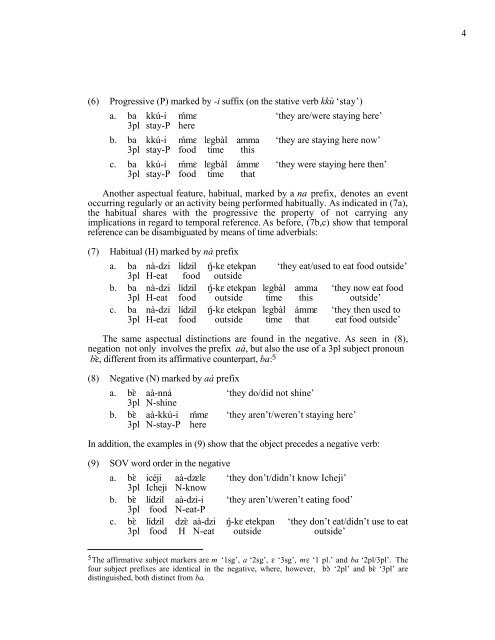Legbo Verb Inflection: A Semantic and Phonological ... - Linguistics
Legbo Verb Inflection: A Semantic and Phonological ... - Linguistics
Legbo Verb Inflection: A Semantic and Phonological ... - Linguistics
You also want an ePaper? Increase the reach of your titles
YUMPU automatically turns print PDFs into web optimized ePapers that Google loves.
(6) Progressive (P) marked by -i suffix (on the stative verb kkù ‘stay’)<br />
a. ba kkú-i m@mE<br />
‘they are/were staying here’<br />
3pl stay-P here<br />
b. ba kkú-i m@mE<br />
lEgbàl amma ‘they are staying here now’<br />
3pl stay-P food time this<br />
c. ba kkú-i m@mE<br />
lEgbàl ámmE ‘they were staying here then’<br />
3pl stay-P food time that<br />
Another aspectual feature, habitual, marked by a na prefix, denotes an event<br />
occurring regularly or an activity being performed habitually. As indicated in (7a),<br />
the habitual shares with the progressive the property of not carrying any<br />
implications in regard to temporal reference. As before, (7b,c) show that temporal<br />
reference can be disambiguated by means of time adverbials:<br />
(7) Habitual (H) marked by nà prefix<br />
a. ba nà-dzi lídzil N@-kE etekpan ‘they eat/used to eat food outside’<br />
3pl H-eat food outside<br />
b. ba nà-dzi lídzil N@-kE etekpan lEgbàl amma ‘they now eat food<br />
3pl H-eat food outside time this outside’<br />
c. ba nà-dzi lídzil N@-kE etekpan lEgbàl ámmE ‘they then used to<br />
3pl H-eat food outside time that eat food outside’<br />
The same aspectual distinctions are found in the negative. As seen in (8),<br />
negation not only involves the prefix aà, but also the use of a 3pl subject pronoun<br />
b $, different from its affirmative counterpart, ba: 5<br />
(8) Negative (N) marked by aà prefix<br />
a. bE$ aà-nná ‘they do/did not shine’<br />
3pl N-shine<br />
b. bE$ aà-kkú-i m@mE<br />
‘they aren’t/weren’t staying here’<br />
3pl N-stay-P here<br />
In addition, the examples in (9) show that the object precedes a negative verb:<br />
(9) SOV word order in the negative<br />
a. bE$ icéji aà-dzElE ‘they don’t/didn’t know Icheji’<br />
3pl Icheji N-know<br />
b. bE$ lídzil aà-dzi-i ‘they aren’t/weren’t eating food’<br />
3pl food N-eat-P<br />
c. bE$ lídzil dzE$ aà-dzi N@-kE etekpan ‘they don’t eat/didn’t use to eat<br />
3pl food H N-eat outside outside’<br />
5 The affirmative subject markers are m ‘1sg’, a ‘2sg’, ‘3sg’, m ‘1 pl.’ <strong>and</strong> ba ‘2pl/3pl’. The<br />
four subject prefixes are identical in the negative, where, however, bç$ ‘2pl’ <strong>and</strong> bE$ ‘3pl’ are<br />
distinguished, both distinct from ba.<br />
4

















